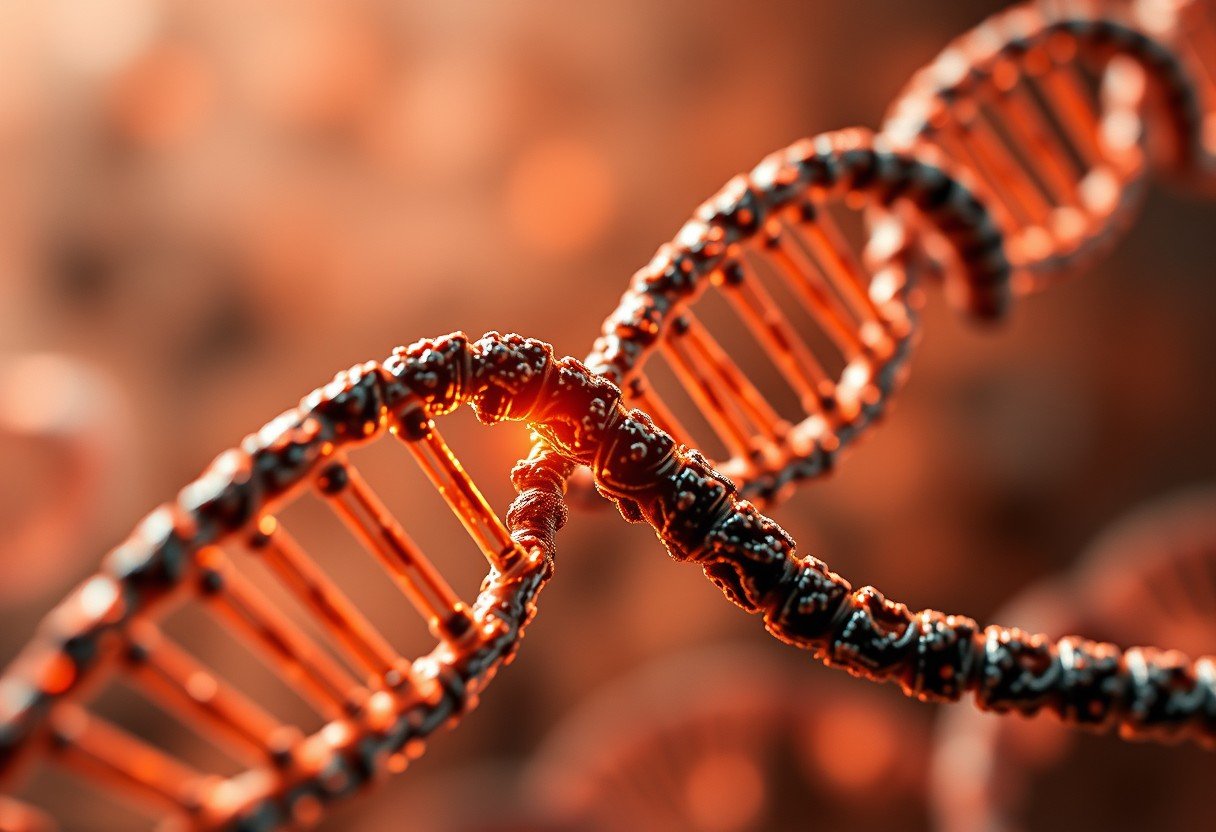DNA ligase is a crucial enzyme that acts like a molecular glue during DNA replication. Its main job is to join together short pieces of DNA on the lagging strand, creating a complete and unbroken new DNA molecule. This process is essential for accurately copying genetic information every time a cell divides, ensuring the stability and integrity of our genome. Without DNA ligase, our genetic code would be left fragmented and full of errors.
Why Does DNA Replication Have a Leading and Lagging Strand?
To understand the role of DNA ligase, it’s important to first grasp why DNA replication involves two different types of strands: a leading and a lagging strand. This difference comes from the structure of DNA and the way the main replication enzyme, DNA polymerase, works.
DNA polymerase can only build a new DNA strand in one direction, from 5′ (five prime) to 3′ (three prime). As the double helix unwinds at the replication fork, one template strand is perfectly positioned for continuous synthesis. This is the leading strand.
The other template strand, however, runs in the opposite direction (3′ to 5′). This means DNA polymerase has to work backwards, away from the replication fork. It synthesizes small chunks of DNA at a time as more of the template becomes exposed. This discontinuously synthesized strand is known as the lagging strand, and it is this strand that presents a unique challenge that DNA ligase is built to solve.
| Feature | Leading Strand | Lagging Strand |
|---|---|---|
| Synthesis Direction | Towards the replication fork | Away from the replication fork |
| Synthesis Method | Continuous | Discontinuous (in fragments) |
| Primers Required | Only one at the start | Multiple primers, one for each fragment |
| Role of DNA Ligase | Not required | Essential for joining fragments |
What Are Okazaki Fragments and How Are They Formed?
The short segments of DNA created on the lagging strand are called Okazaki fragments, named after their discoverers Reiji and Tsuneko Okazaki. These fragments are the direct result of the discontinuous synthesis required to copy the 3′ to 5′ template strand.
The process begins when an enzyme called primase creates a small RNA primer on the template strand. This primer acts as a starting point for DNA polymerase. The polymerase then adds DNA nucleotides to the primer, creating an Okazaki fragment, until it runs into the primer of the previous fragment. This process repeats over and over again along the lagging strand.
Once an Okazaki fragment is complete, another enzyme (often DNA polymerase I) removes the RNA primer and replaces it with DNA nucleotides. However, this replacement process leaves a small gap, or “nick,” in the sugar-phosphate backbone between the newly synthesized fragment and the one before it.
The Main Job of DNA Ligase: Sealing the Gaps
This is where DNA ligase takes center stage. Its primary and most critical function is to seal these nicks, joining the Okazaki fragments into a single, continuous DNA strand. It acts as the final step in completing the lagging strand.
DNA ligase accomplishes this by creating a strong covalent bond known as a phosphodiester bond. This bond connects the 3′ end of one DNA fragment to the 5′ end of the adjacent fragment, effectively repairing the break in the DNA backbone. This ligation process requires energy, which the enzyme gets from a molecule called ATP (in eukaryotes and archaea) or NAD+ (in bacteria).
The mechanism of DNA ligase can be broken down into a few key steps:
- The enzyme first binds to the nick between two Okazaki fragments.
- Using energy from ATP, DNA ligase activates the 5′ phosphate group on one side of the nick.
- Finally, it facilitates the chemical reaction that forms the phosphodiester bond, sealing the gap and creating an unbroken strand.
Without this crucial action, the lagging strand would remain a collection of disconnected pieces, making the DNA molecule unstable and non-functional.
How DNA Ligase Works with Other Replication Enzymes
DNA ligase does not work in isolation. It is part of a highly coordinated team of enzymes and proteins often called the replisome, which ensures that DNA replication is both fast and accurate. Its collaboration with other enzymes is vital for the process to run smoothly.
The most important partnership is with DNA polymerase. As DNA polymerase synthesizes the Okazaki fragments and another version of it replaces the RNA primers, it sets up the nicks that are the specific targets for DNA ligase. The two enzymes work in sequence: polymerase builds and replaces, then ligase seals.
Furthermore, DNA ligase collaborates with other enzymes involved in maintaining DNA integrity. For example, helicase is the enzyme that unwinds the DNA double helix to create the replication fork, and various repair enzymes are constantly checking for and fixing errors. DNA ligase contributes to this broader system by ensuring the final product of replication is structurally sound, which is a key part of maintaining genomic stability.
What Happens if DNA Ligase Stops Working?
A failure in DNA ligase function has severe consequences for the cell. If the enzyme is defective or absent, the nicks between Okazaki fragments on the lagging strand will not be sealed. This results in newly synthesized DNA that is fragmented and incomplete.
Such fragmented DNA is highly unstable and prone to breaking, which can lead to chromosomal damage. The accumulation of these unsealed nicks compromises the fidelity of DNA replication, increasing the rate of mutations. These mutations can have devastating effects, potentially leading to cell death or uncontrolled cell growth, which is a hallmark of cancer.
In humans, mutations in the genes that code for DNA ligase are linked to rare genetic disorders. For instance, mutations in the DNA Ligase I gene can cause a condition known as Losso syndrome, which is characterized by immune deficiencies, developmental delays, and a predisposition to cancer. This highlights the critical importance of DNA ligase in safeguarding our genetic material from one generation of cells to the next.
Future Research and Therapeutic Uses of DNA Ligase
While the primary role of DNA ligase in replication is well understood, research continues to uncover more about its functions. Scientists are learning that it plays a broader role in various DNA repair pathways, helping to fix damage caused by environmental factors like UV radiation or chemical mutagens.
This deeper understanding has opened up exciting possibilities for therapeutic applications. Since cancer cells replicate their DNA rapidly and often have compromised DNA repair systems, they can be particularly vulnerable to drugs that inhibit DNA ligase. Researchers are exploring DNA ligase inhibitors as a potential cancer therapy to selectively kill tumor cells.
Furthermore, DNA ligase is an indispensable tool in molecular biology and genetic engineering. Scientists use purified DNA ligase in the lab to join pieces of DNA together, a fundamental technique for creating recombinant DNA, cloning genes, and advancing gene therapy technologies. As our knowledge grows, DNA ligase will likely become an even more important target and tool in medicine.
Frequently Asked Questions about DNA Ligase
What is the main role of DNA ligase in cells?
The main role of DNA ligase is to join fragments of DNA together by forming phosphodiester bonds. Its most critical function is during DNA replication, where it seals the gaps between Okazaki fragments on the lagging strand to create a continuous DNA molecule.
Why is the lagging strand made in pieces?
The lagging strand is made in short pieces, called Okazaki fragments, because the DNA polymerase enzyme can only build DNA in one direction (5′ to 3′). Since the lagging strand template runs in the opposite direction, the polymerase must synthesize it discontinuously as the DNA helix unwinds.
What are Okazaki fragments?
Okazaki fragments are the short, newly synthesized DNA segments that are formed on the lagging strand during DNA replication. Each fragment is initiated by an RNA primer and is later joined together by DNA ligase to form a complete strand.
Can DNA replication happen without DNA ligase?
While the synthesis of DNA fragments can occur, the replication process cannot be successfully completed without DNA ligase. The absence of this enzyme would leave the lagging strand as a series of disconnected fragments, leading to an unstable and non-functional chromosome.
Does DNA ligase need energy to work?
Yes, DNA ligase requires an energy source to function. In human cells and other eukaryotes, it uses a molecule called ATP (adenosine triphosphate) to power the reaction that seals the nicks in the DNA backbone.









Leave a Comment